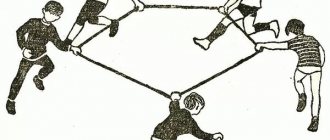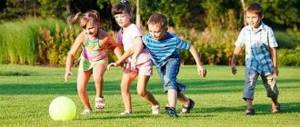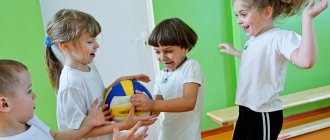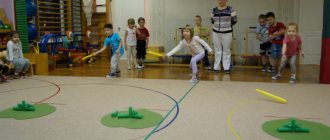For the development of a harmonious personality, mathematics classes for children will be very useful, which can be started from 3-4 years old - it is at this age that children begin to develop their first mathematical concepts. Do not forget that preschoolers should be taught through play, using dolls, pictures, unusual methods and techniques to maintain interest - this is the only way the effect will be maximum, knowledge will be stored in the head for a long time, and the child will not lose interest in the process.
Tips for parents
To make math classes not only useful, but also interesting and fun, you should adhere to the following recommendations:
- Act according to the principle “from simple to complex”: first offer the child those tasks that he can cope with, do not rush, work through the material in detail and do not take on new things while there are gaps in the old. You should not compare your child with other children, because everyone’s development follows an individual path, and what is understandable to one child may be very difficult for another. This is important to consider.
- Parental praise is a powerful motivation and should always be used, even if the successes are not impressive. You can at least praise your efforts.
- Of the two options - to hammer useful material into the child’s head at any cost or to instill in him curiosity and a desire to learn - without a doubt, you need to choose the second. Over time, the child will remember numbers, quantities, and learn to navigate in space, but if he loses interest in the process, then it will not be easy to regain it.
- Correct choice of task. The secret of success is to give the child a moment of small discovery, so tasks need to be selected so that he can cope. Success will help you gain and strengthen self-confidence.
You shouldn't push your baby. If he uses his fingers when learning to count, it’s okay. Very often, those children who have already learned to count orally test themselves in this way. Over time, they will gain self-confidence and will not use their fingers.
Math games with movements
TARGET. Cultivating interest in physical exercise and sports, the desire for a healthy lifestyle through mathematical and logical games.
MORE LESS
TARGET. Develop the ability to compare objects in the surrounding world by size, auditory-motor coordination of movements.
PROGRESS OF THE GAME. The teacher names objects and items: elephant, soccer ball, bicycle, tennis ball, tree, pin, etc. If the named object is larger than the previous one, then the children stand on their toes, hands up. If the named object is smaller than the previous one, they squat. The one who never makes a mistake wins.
OPTION. In the same way, knowledge about the concepts of higher - lower, wider - narrower, thicker - thinner, longer - shorter, etc. is consolidated.
SHOW IT DIFFERENTLY
TARGET. Learn comparison operations, improve coordination abilities.
PROGRESS OF THE GAME. The children walk at a normal pace. When given a signal, perform the appropriate movements.
Signals: “High gate” (normal walking), “Low gate” (walking in a half-squat), “Heavy bags” (arms down, tense, fists clenched); “Light bag” (walking, swinging your arms); “We’re going skiing”, “Running a marathon”, “Catching up with someone running away”; “We play Hopscotch, etc.”
WHO KNOWS, LET THEM CONTINUE
TARGET. Strengthen the skill of ordinal counting within 10, develop coordination of movements, auditory attention
MATERIAL: ball
PROGRESS OF THE GAME. Children stand in a circle. The leader is in the center of the circle with the ball. In accordance with the leader’s commands, players count in order to 10.
Complication: the leader takes the ball before the player counts to 10, throws it to the next one with the words “Count on”
OPTION. The host throws the ball and says “Until five.” The child names numbers up to 5. If the command “After five” is given, children name numbers after five.
SILENT HUNT
TARGET. Develop the ability to solve mathematical examples, improve coordination and speed abilities.
MATERIAL: dummies or pictures depicting berries and mushrooms with examples and baskets with numbers
PROGRESS OF THE GAME. There are 2 teams of boys and girls playing. The teacher gives the command: “Boys, get mushrooms!” (“Girls, go get some berries!”). Children put 2 or 3 objects in baskets so that the total numbers on the objects correspond to the number on the basket. On the command “Stop!” the collection stops. The team that collects the most mushrooms or berries wins.
STRONG WIND BLOWS
TARGET. Develop auditory attention, thinking, coordination of movements
PROGRESS OF THE GAME. Everyone stands in a circle, holding hands and loudly repeating the magic words: “A strong wind is blowing, one, two, three!” Then one child, to whom the presenter points, says: “Those who love ... (ride a bicycle, swim in the pool, jump rope, etc.) change places. Everyone who enjoys doing this runs to another place in the circle.
After this, the children join hands again and the game continues.
OPTION: “Those who know how to change places...”
ONE TWO THREE FOUR FIVE
TARGET. Teach children to act alone and together with others; develop children's organizational skills; develop children’s attention, their spatial orientation, and speed of reactions; practice counting and basic movements.
PROGRESS OF THE GAME. To the music, children move around the room in different directions, using energetic walking, running, and jumping, depending on the nature of the music. When the music ends, the teacher calls out the first number. Children should line up in pairs, threes, etc., in accordance with the named number, standing in a circle or line and raising their hands up.
GET TO KNOW A FRIEND
TARGET. Improve tactile sensations and the ability to navigate in space.
MATERIAL: blindfold
PROGRESS OF THE GAME. The driver is selected and blindfolded. The rest stand in a circle. The driver calls any number. The teacher follows the children and, touching each one on the shoulder, counts together with the children the number indicated by the leader. The driver must find the one they settled on, one by one feeling the children’s hair and clothes.
OPTION. The driver names numbers greater than 5, less than 8, greater than 10, but less than 15, etc.
OCCUPY YOUR HOUSE
TARGET. Develop reaction speed, improve spatial orientation. Clarify the names of colors, geometric shapes, numbers.
MATERIAL: multi-colored flags, colored houses. For version 1 of the game, various objects or pictures depicting objects. The houses have geometric shapes. For version 2 of the game - number cards, on the houses - numbers.
PROGRESS OF THE GAME. Models of houses with symbols (color) are located in various places. At the signal “Occupy your house,” children approach the houses. The one who makes a mistake receives a penalty point.
OPTION 1. Children approach the house if the object looks like this geometric figure.
OPTION 2. Occupy the house according to the number card.
SECRET MOVEMENT
TARGET. Develop visual and motor memory and the relationship between them.
PROGRESS OF THE GAME. The presenter shows various gymnastic exercises. The participants of the game repeat after the leader all the exercises, except for the secret one – the one agreed upon in advance. Instead of this exercise, children must perform another one, also agreed upon in advance. For example, hop on your right leg 3 times.
Children who completed the exercises without errors are noted.
THIS IS THE POSE
TARGET. Develop motor and visual memory, voluntary self-control, stability of attention.
PROGRESS OF THE GAME. The driver first determines the number of “I will remember 4 (3) poses.” 4 (3) people come out and take poses corresponding to a particular sport. After looking at them, the driver must remember, reproduce and comment after all the children return to their starting position.
If all poses are reproduced, the driver receives the same number of points. Each error is -1.
MAGIC NUMBER
TARGET. Strengthen mathematical calculations, improve memory, develop coordination abilities.
MATERIAL: cards with numbers on a carpet or mat.
PROGRESS OF THE GAME. Children are told its magic number. At the signal, all participants run to the mat and find their number, then run around the mat to the right and return to the starting point.
Children who quickly and correctly completed the task and ended up in the Land of Knowledge are celebrated.
FIND A PAIR
TARGET. Improve the perception of the number of objects. Develop attention and speed of movement.
MATERIAL: various number cards
PROGRESS OF THE GAME. Children take one number card at a time and walk around. At the command “Find a pair!” players quickly find a pair of number cards with the same number of items, join hands and form a column.
The first couple to complete the task wins
FIND YOUR WAY
TARGET. Development of skills to identify and abstract the properties of objects. Improve motor skills.
MATERIAL: Dienesh logic blocks, large panel with a labyrinth.
RULES OF THE GAME. Go to the house, take the object and perform the appropriate number of movements. Signs at forks in the road indicate which path to take.
LISTEN, MOVE, COUNT
TARGET. Develop auditory attention, speed of motor reaction
PROGRESS OF THE GAME. While moving around the room, the players perform the tasks of the leader:
- one whistle - jump up, two whistles - turn around, three whistles - walking with a high hip lift, etc.;
- performing movements in a certain sequence: - two jumps up, two jumps forward;
– three steps – balance on the right leg, three steps – balance on the left leg.
MOBILE ACCOUNT
TARGET. Improve your ability to solve arithmetic examples. Develop coordination abilities and motor flexibility.
MATERIAL: cubes with numbers on the opposite side of the cards with arithmetic examples.
PROGRESS OF THE GAME. A presenter is selected. He shows one of the example cards. Children, having solved it, run to the cubes with numbers and return to the presenter, who checks the correctness of the solution. Whoever completed the task first becomes the leader.
OPTION. Examples with an unknown term.
Tasks and exercises by age
The simplest options for preschoolers 3–4 years old are games with fingers.
- Using your fingers, show the same number in different ways (for example, 5 is 4 and 1, 2 and 3, 5 and 0).
- It is necessary to bend several fingers, the child’s task is to name the exact number.
In addition to fingers, you can use other counting materials - buttons, sticks, pencils, shells - anything that is interesting to the baby.
Exercises at home
There are many interesting games that you can play at home with kids 3-4 years old. For example, circle a number. The mother prepares the material in advance - on a piece of paper she writes numbers familiar to the child in a chaotic order, then asks him to find all the twos and circle them. The task can be made more difficult by suggesting that you circle the twos in blue, the threes in green, and the ones in red.
Mathematics is not only counting, but also logic, so you can play the game “Make a bouquet” with your child. To do this, draw a blank: simple pots, from which three stems are visible. You also need to prepare a set of buttons in three colors in advance. Next, mom gives the task - to select “flowers” for each pot so that one of them must be blue or so that there are blue and red flowers next to each other in each pot. The task is also good because it trains fine motor skills.
You can come up with games yourself using available materials. For example, invite your child to make a caterpillar out of multi-colored buttons, using 3 red, 4 blue, 1 green buttons. So that the baby does not forget the combinations, you need to draw a square, paint it with the appropriate color, and write a number next to it. Using colored rectangles, you can make a train with carriages in the same way.
Many children love to draw and color; this can also be used during classes by offering kids coloring books with numbers (you can draw them yourself or use ready-made options). The essence of such drawings is simple: the child is given a picture that he needs to color in different colors. The image is divided into blocks marked with numbers, each of which has its own color.
At 3–4 years old, children need to be introduced to geometric shapes. The following tasks are suitable for this:
- The parent draws a series of shapes (circle - square - triangle - rectangle), then asks the child to show, for example, a circle.
- Further, the task becomes more complicated - you need to color the circle red, the square green, the triangle blue, and leave the rectangle white.
To prevent your child from getting bored, you can come up with a fairy tale about the magical world of figures who are in trouble. Only completing tasks correctly will help save them.
Outdoor games
Don’t think that math classes with a preschooler are something boring. If you get creative, you can have some fun. So, there are several fun and useful games:
- "One to four." The mother hums a song and then says a number from 1 to 4. As soon as it sounds, the child must take a certain position, touching the floor with the number of points indicated by the named number (for example, if it is 1, then you need to stand on one leg, if 2 - just stay standing on two legs, 3 – lean on your hand and both legs, 4 – on your arms and legs at the same time).
- "Meow-woof." The mother gives the instruction: the child must jump forward as many times as she says “meow”, and back as many times as she says “woof”. To perform this, the baby first counts his mother’s phrases, and then his own jumps.
You can do math with your little one on the street, asking him to count all the cats he meets on the way, or find the number 3 everywhere, or show him objects that are shaped like a circle. You can also ask your child to compare which car is bigger, what is next - a shop or a store, and give similar tasks.
Obtaining mathematical skills can and should be organized in a playful way. Only in this case will the child have fun and unnoticed remember the necessary material.






